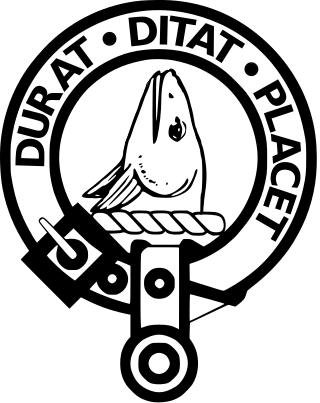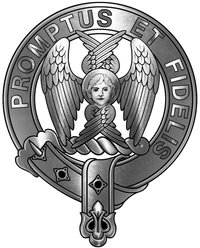An armigerous clan (from armiger) is a Scottish clan, family or name which is registered with the Court of the Lord Lyon and once had a chief who bore undifferenced arms, but does not have a chief currently recognised as such by Lyon Court.
Before 1745 all chiefs had arms; however, not all of these are recorded in the Public Register of All Arms and Bearings in Scotland , which was established in 1672.
In Scottish heraldry, only chiefs or heads of clans, families, or names bear undifferenced arms. A clan is considered a "noble incorporation" because a clan chief is a title of honour in Scotland and the chief confers his or her noble status onto the clan. Because armigerous clans do not have such chiefs, they are not recognised as noble communities and have no legal standing under Scots law. [1] [2] [3] [4]

A coat of arms is a heraldic visual design on an escutcheon, surcoat, or tabard. The coat of arms on an escutcheon forms the central element of the full heraldic achievement, which in its whole consists of a shield, supporters, a crest, and a motto. A coat of arms is traditionally unique to the armiger. The term 'coat of arms' itself, describing in modern times just the heraldic design, originates from the description of the entire medieval chainmail 'surcoat' garment used in combat or preparation for the latter.

A Scottish clan is a kinship group among the Scottish people. Clans give a sense of shared identity and descent to members, and in modern times have an official structure recognised by the Court of the Lord Lyon, which regulates Scottish heraldry and coats of arms. Most clans have their own tartan patterns, usually dating from the 19th century, which members may incorporate into kilts or other clothing.

The Right Honourable the Lord Lyon King of Arms, the head of Lyon Court, is the most junior of the Great Officers of State in Scotland and is the Scottish official with responsibility for regulating heraldry in that country, issuing new grants of arms, and serving as the judge of the Court of the Lord Lyon, the oldest heraldic court in the world that is still in daily operation.

In heraldry, cadency is any systematic way to distinguish arms displayed by descendants of the holder of a coat of arms when those family members have not been granted arms in their own right. Cadency is necessary in heraldic systems in which a given design may be owned by only one person at any time, generally the head of the senior line of a particular family.

In Scotland, a baron or baroness is the head of a feudal barony, also known as a prescriptive barony. This used to be attached to a particular piece of land on which was situated the caput or essence of the barony, normally a building, such as a castle or manor house. Accordingly, the owner of the piece of land containing the caput was called a baron or baroness. According to Grant, there were around 350 identifiable local baronies in Scotland by the early fifteenth century and these could mostly be mapped against local parish boundaries. The term baron was in general use from the thirteenth century to describe what would have been known in England as a knight of the shire.
A laird is the owner of a large, long-established Scottish estate. In the traditional Scottish order of precedence, a laird ranked below a baron and above a gentleman. This rank was held only by those lairds holding official recognition in a territorial designation by the Lord Lyon King of Arms. They are usually styled [name] [surname] of [lairdship]. However, since "laird" is a courtesy title, it has no formal status in law.

The law of heraldic arms governs the "bearing of arms", that is, the possession, use or display of arms, also called coats of arms, coat armour or armorial bearings. Although it is believed that the original function of coats of arms was to enable knights to identify each other on the battlefield, they soon acquired wider, more decorative uses. They are still widely used today by countries, public and private institutions and by individuals. The earliest writer on the law of arms was Bartolus de Saxoferrato. The officials who administer these matters are called pursuivants, heralds, or kings of arms. The law of arms is part of the law in countries which regulate heraldry, although not part of common law in England and in countries whose laws derive from English law.

Heraldry in Scotland, while broadly similar to that practised in England and elsewhere in western Europe, has its own distinctive features. Its heraldic executive is separate from that of the rest of the United Kingdom.
The personal name Duncan can be found in Scotland’s oldest records in its Gaelic form Dunchad/Donchadh/Donachie/Donnchadh and other spelling variants.

The Scottish Gaelic word clann means children. In early times, and possibly even today, Scottish clan members believed themselves to descend from a common ancestor, the founder of the clan, after whom the clan is named. The clan chief is the representative of this founder, and represents the clan. In the Scottish clan system, a chief is greater than a chieftain (ceann-cinnidh), a designation applied to heads of branches of a clan. Scottish clans that no longer have a clan chief are referred to as armigerous clans.

Clan MacAulay, also spelt Macaulay or Macauley is a Scottish clan. The clan was historically centred on the lands of Ardincaple, which are today consumed by the little village of Rhu and burgh of Helensburgh in Argyll and Bute. The MacAulays of Ardincaple were located mainly in the traditional county of Dunbartonshire, which straddles the "Highland Line" between the Scottish Highlands and Lowlands. Clan MacAulay has been considered a "Highland clan" by writers and has been linked by various historians to the original Earls of Lennox and in later times to Clan Gregor. The MacAulays of Ardincaple, like Clan Gregor and several other clans, have traditionally been considered one of the seven clans which make up Siol Alpin. This group of clans were said to have claimed descent from Cináed mac Ailpín, King of the Picts, from whom later kings of Scotland traced their descent. The chiefs of Clan MacAulay were styled Laird of Ardincaple.

A Scottish crest badge is a heraldic badge worn to show allegiance to an individual or membership in a specific Scottish clan. Crest badges are commonly called "clan crests", but this is a misnomer; there is no such thing as a collective clan crest, just as there is no such thing as a clan coat of arms.

Clan Campbell of Cawdor is a highland Scottish clan and a branch of the larger Clan Campbell. While the clan is recognised by the Standing Council of Scottish Chiefs, the clan does not have a clan chief recognised by the Standing Council of Scottish Chiefs. Also, because the clan does not have a clan chief recognised by the Lord Lyon King of Arms it is considered an armigerous clan. The head of the Clan Campbell of Cawdor is the Earl Cawdor, currently held by Colin Campbell.

A slogan is used in Scottish heraldry as a heraldic motto or a secondary motto. It usually appears above the crest on a coat of arms, though sometimes it appears as a secondary motto beneath the shield. The word slogan dates from 1513. It is a variant of the earlier slogorn, which was an Anglicisation of the Scottish Gaelic sluagh-ghairm. In other regions it is called war-cry.

Clan Craig is a Scottish clan hailing from Aberdeenshire. The clan does not have a chief recognized by the Lord Lyon King of Arms, therefore the clan has no standing under Scots Law. Clan Craig is considered an armigerous clan, meaning that it is considered to have had at one time a chief who possessed the chiefly arms, however no one at present is in possession of such arms.

Clan Ged is a Scottish clan. The clan does not currently have a chief recognised by the Lord Lyon King of Arms and is considered an armigerous clan. Without a recognised chief the clan has no standing under Scots Law. In Scotland, the surname Ged and Geddes may be derived from the place-name Geddes in Nairn. Another possibility is that it is derived from the Old English gedda, a nickname meaning pike.

Clan Kinninmont is a Scottish clan. The clan does not have a chief recognised by the Lord Lyon King of Arms, therefore the clan has no standing under Scots Law. Clan Kinninmont is considered an armigerous clan, meaning that it is considered to have had at one time a chief who possessed the chiefly arms, however no one at present is in possession of such arms. The original chiefly line died out when an heiress married into another family. The successors of this heiress, are the Earls of Minto, whose patronyme is that of „Elliot-Murray-Kynynmound“, Kynynmound being a variation of Kinninmont, this family bears, as part of its arms, the arms the clan.

Clan Walkinshaw is a Scottish clan. It does not have a chief recognised by the Lord Lyon King of Arms therefore the clan has no standing under Scots Law. Clan Walkinshaw is considered an armigerous clan, meaning that it is considered to have had at one time a chief who possessed the chiefly arms, however no one at present is in possession of such arms.

The Court of the Lord Lyon, or Lyon Court, is a standing court of law, based in New Register House in Edinburgh, which regulates heraldry in Scotland. The Lyon Court maintains the register of grants of arms, known as the Public Register of All Arms and Bearings in Scotland, as well as records of genealogies.

Clan Carruthers is a Lowland Scottish clan of the Scottish Borders headed by their Chief, Simon Peter Carruthers of Holmains and is recognised as such by the Lord Lyon King of Arms.